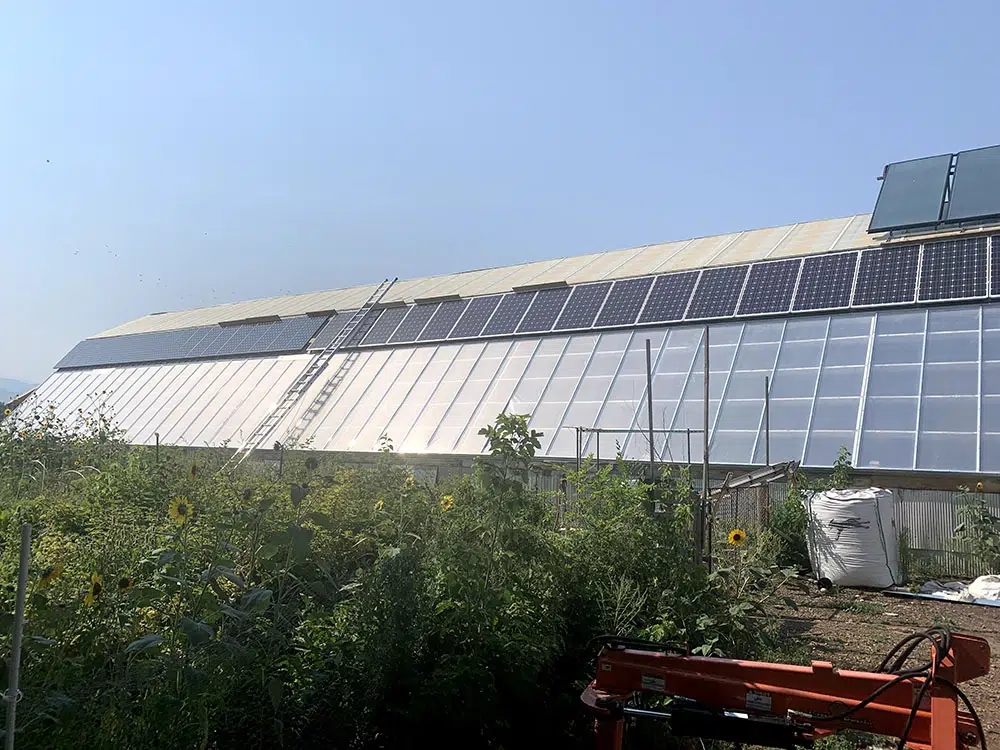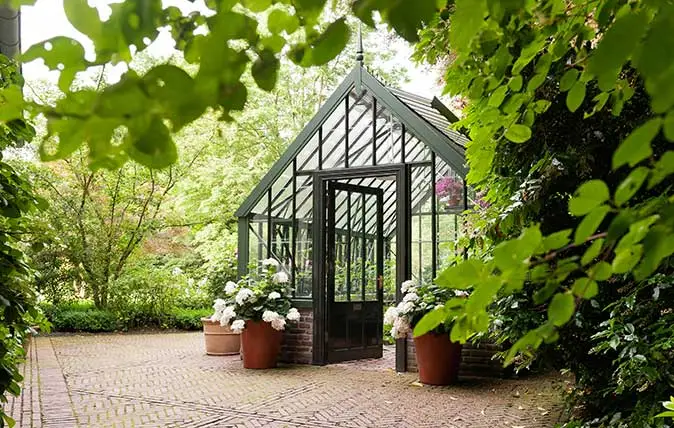By harnessing the sun’s power, solar-powered greenhouses provide sustainable growth conditions for plants regardless of external climate conditions. Whether you’re a gardening enthusiast, a professional farmer, or someone interested in sustainable technologies, this guide aims to enlighten and inspire you toward a greener future.
What Is a Solar-Powered Greenhouse?
A solar-powered greenhouse is a structure that uses the sun’s energy to heat up and provide light and energy for plants and crops. There are different types of solar greenhouses, and each comes with its strengths and weaknesses. Solar-powered greenhouses can utilize renewable solar energy to provide the greenhouse with power and maintain a comfortable environment for plant growth. Even if the weather outside the greenhouse is less than ideal for plant growth, a solar greenhouse’s controlled internal environment can be tailored explicitly for successful growth.

How Do Solar-Powered Greenhouses Work?
Solar greenhouses should be south-facing for best results; this area is designed to maximize sunlight retention and optimize energy generation. The north end will be well-insulated to prevent heat loss, while the longest axis of the greenhouse stretches from east to west. You’ll also notice that most solar greenhouses are made of glass to ensure complete absorption of sunlight. Natural ventilation features help maintain the temperature, keeping things cooler in the summer and minimizing heat loss in the winter.
Greenhouse solar panels work like regular panels, capturing sunlight and converting it into usable energy. If your greenhouse incorporates solar panels, you can use their electricity to power a wide range of devices to keep your plants happy all year round.
Solar powered fan effectively controls the temperature and humidity inside the greenhouse to ensure the optimum growing environment for your plants. By installing a solar powered greenhouse fan on top or on the side of the greenhouse, natural ventilation can be achieved, reducing plant diseases caused by high temperatures and high humidity.
The Benefits of Using Solar Energy to Power Your Greenhouse
A solar-powered greenhouse offers numerous benefits for growing plants and crops. From saving money and improving plant results to doing good for the environment, here are several benefits you’ll gain if you rely on the sun’s power to keep your greenhouse running.
- Reduced Energy Cost: The initial cost of installing a solar-powered energy system for your greenhouse can be significant, but the long-term savings it provides can’t be ignored. Using renewable energy sources to power your greenhouse can significantly reduce your monthly energy costs.
- Improved Yield: Solar-powered greenhouses can provide a more consistent and stable environment for plant growth, which can lead to higher yields and better quality crops.
- Eco-Friendly: Solar energy is a clean and renewable energy source that doesn’t produce harmful emissions or pollutants. By using solar energy to power your greenhouse, you’re doing your part to reduce your carbon footprint and protect the environment.
- Low Maintenance: Solar panels require very little maintenance once installed, making them an ideal choice for busy greenhouse owners.
- Energy Independence: By relying on solar energy to power your greenhouse, you’re no longer dependent on the grid for your energy needs. This can be especially beneficial if you live in a remote area or if you’re concerned about power outages.
- Scalability: Solar-powered greenhouses can be scaled up or down depending on your needs. Whether you’re growing a few plants or running a large commercial solar to sell, solar energy can provide the power you need.
- Versatility: Solar energy can be used to power a wide range of devices and equipment, including fans, heaters, and lighting systems.

Challenges of Solar-Powered Greenhouses
When we talk about the challenges of solar greenhouses, we need to consider several factors.
- It costs a lot of money to build a solar greenhouse because of the installation of solar panels and related equipment.
- The supply of solar energy is unstable as it is affected by weather and time of day, which means that the greenhouse may sometimes not have enough energy. To solve this problem, we need to use energy storage technologies such as batteries, but this adds to the cost.
- Solar power can vary depending on the seasons, for example in winter when there is less sunlight. Therefore, we need alternate sources of energy to cope with these situations.
- There are many factors to consider when designing a solar greenhouse, such as orientation, shade, and placement of solar panels. What’s more, solar heating and cooling
- systems need to be kept efficient to ensure that the temperature inside the greenhouse is suitable for plant growth.
- Finally, solar equipment requires regular maintenance as it can be affected by dust, dirt, and weather and fail.
Despite these challenges, solar greenhouses remain a viable sustainable solution as technology advances and policies support them.
How Many Watts Does a Greenhouse Use?
Solar greenhouses are a very efficient way to grow food and can benefit greatly from additional electric lighting. About 30% of the cost of running a greenhouse comes from the electricity used for lighting.
When all the lights and heaters are on, the system uses up to 150 watts. However, it is not usually on full power all the time. Assuming cold weather, the power consumption fluctuates between 50 and 120 watts. This is roughly equivalent to the cost of running a freezer, which is between $0.50 and $2 per hour at $0.15/kWh.
In the summer and on sunny winter days, it uses almost no electricity. Electricity consumption in a garden is usually 20 watts per hour or about $10 to $12 per day.
How Much Solar Power Does a Greenhouse Need?
The amount of solar power needed to build a solar greenhouse depends on some factors, including the temperature you wish to maintain inside the greenhouse, the local sunlight conditions, the insulation of the greenhouse, and more. Here are some considerations:
- Electricity needed for the greenhouse: Greenhouses typically require electricity to maintain temperature, lights, ventilation, and other equipment. You will need to calculate the total power requirements for these devices.
- Local sunlight conditions: Sunlight conditions vary from region to region. California usually has good sunlight conditions, but the exact amount of sunlight will vary depending on the location.
- Insulation of the greenhouse: The better insulated your greenhouse is, the less solar power you may need. Good insulation reduces energy loss and mitigates temperature differences between the inside and outside of the greenhouse.
To estimate the amount of solar electricity needed, you can follow these steps:
Step 1: Determine the Power Requirements of the Devices
List all the devices you plan to use inside the greenhouse and record their power requirements in watts (W). For example, heaters, lights, ventilation systems, etc. Sum these power requirements to get the total power demand.
Total Power Demand = Heater Power + Light Power + Ventilation System Power + …
Step 2: Understand Local Sunlight Conditions
Find the annual average sunlight hours for your location. In California, sunlight hours are relatively long due to generally clear weather. Convert the annual sunlight hours to hours per day.
Average Daily Sunlight Hours = Annual Average Sunlight Hours / 365
Step 3: Calculate the Average Daily Solar Power Needed
Use the total power demand and average daily sunlight hours to calculate the average daily solar power needed.
Average Daily Solar Power Needed = Total Power Demand / Average Daily Sunlight Hours
Step 4: Consider System Efficiency and Additional Consumption
Typically, solar power systems are not 100% efficient. Consider system losses and additional consumption to ensure stable operation. You can add a safety factor to the calculated value.
Actual Daily Solar Power Needed = Average Daily Solar Power Needed * Safety Factor
Step 5: Calculate the Number of Solar Panels
Use the rated power of the solar panels you plan to use to calculate the required number of solar panels.
Number of Solar Panels Needed = Actual Daily Solar Power Needed / Rated Power per Solar Panel
| Greenhouse | Watts | Length of Use | Solar Power Needed |
| Average Power | 50W-150W | 8H | 400W-1200W |
| Greenhouse Lighting | 20W-40W | 8H-10H | 80W-90W |
| Greenhouse Heating | 500W | 8H | 4000W |
| Greenhouse Watering | 200W-300W | 3H-5H | 600W-1500W |

Frequently Asked Questions
What is the best orientation for a solar greenhouse?
The best orientation for a solar greenhouse is south-facing. This area is designed to maximize sunlight retention and optimize energy generation.
What are the benefits of using solar energy to power your greenhouse?
Using solar energy to power your greenhouse can save money, improve plant results, and do good for the environment.
How much solar power does a greenhouse need?
The amount of solar power your greenhouse needs depends on several factors, including the size of your greenhouse, the number of plants you’re growing, and the amount of sunlight your location receives.
Can solar panels power a greenhouse?
Yes, solar panels can effectively power a greenhouse. They provide renewable energy to run various operations within the greenhouse, such as lighting, ventilation, irrigation systems, and climate control.
How many solar panels do I need to run a greenhouse?
The number of solar panels required depends on factors like the size of the greenhouse, its energy needs, geographic location, and solar panel efficiency.
Generally, a solar energy system for a greenhouse is custom-designed to meet specific requirements. A consultation with a solar energy expert or contractor is recommended to determine the exact number of panels needed.
How much does it cost to build a solar greenhouse?
The cost of building a solar greenhouse varies based on factors like size, design complexity, materials used, location, and climate considerations. Solar panels themselves constitute a significant portion of the cost, along with other components like batteries, inverters, and installation expenses.
A rough estimate for a solar greenhouse could range from several thousand to tens of thousands of dollars. However, the long-term savings on energy bills and potential incentives or rebates for renewable energy projects can offset some of the initial costs.
How much power do you need for a greenhouse?
The power requirement for a greenhouse depends on several factors, including its size, climate, type of crops grown, and technological systems used (such as lighting, heating, cooling, and irrigation). Energy needs can vary widely among different greenhouse setups. Generally, a comprehensive assessment of energy requirements is necessary to determine the precise power needs for a specific greenhouse operation. This assessment helps in sizing the solar energy system appropriately to meet the greenhouse’s demands while ensuring reliable and efficient operation.
Final Thoughts
Solar-powered greenhouses are an excellent way to grow plants and crops sustainably. By harnessing the power of the sun, you can reduce your energy costs, improve your yield, and do your part to protect the environment. Whether you’re a gardening enthusiast or a professional farmer, a solar-powered greenhouse is an investment that will pay off in the long run.











